 Illumination, expressed in lux, is being measured frequently. There are a number of norms that give recommended values for lux at dif ferent workspots, roads etc. Final customers seeking installers for lighting, can require these norms to be met. Measurements are normally done with luxmeters, but not all give the correct readings.
Illumination, expressed in lux, is being measured frequently. There are a number of norms that give recommended values for lux at dif ferent workspots, roads etc. Final customers seeking installers for lighting, can require these norms to be met. Measurements are normally done with luxmeters, but not all give the correct readings.
This article explains the measurement technique of two meters that both measure lux and therefore could be used to verify a lighting installation. However both do it on its own way and depending on the spectrum of the light of the lighting installation, each type of lux meters give significant different results.
The cause for this is also explained and the article concluded with recommendations.
Lux meters and measurement principles
In this article to different illuminance meters are explained and used, both having their own way of measuring the illuminance in lux.
One light sensitive cell
The first lux meter is one that works with one light sensitive cell. This cell measures the incident light (all light in the visible spectrum is measured) and evaluates that against the human daylight sensitivity curve (see the first image in this article, the red curve). The resulting value is the measurement result in lux.
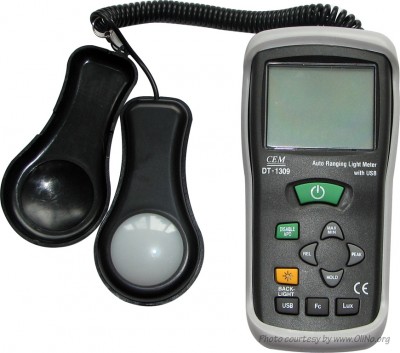
The CEM DT-1309 lux meter, works with one light sensitive cell
Many lux measurement devices work according to this principle. They use one light sensitive cell. The sensitivity for visible light for this cell is for sure different than that of the human eye’s. The result is that the reading of the light cell is not giving a lux value. There are some ways to solve this issue:
(1) the cheapest kind of lux meters will have one correction factor applied, that corrects the measured value of the cell into the value that it should be when the sensitivity of a human eye would have been used. This works well, but as we will see later it requires a different correction factor for every light spectrum. However these lux meters work with one correction factor and of considerable errors are made when light is measured with a significant different spectrum (see further).
(2) the much more expensive lux meters with one cell are optimized and tuned with optical filters and lenses such that the sensitivity of this set of lenses and the cell itself directly matches the eye’s light sensitivity curve (so only one correction value needed for light of any spectral content). Very expensive lux meters come as close as 1.5 % uncertainty to the human eye’s sensitivity curve (class L which are the best), where this 1.5 % is true as an average value for the whole curve. Note that however a (much) larger error is to be expected when only a small spectral band is considered!
These type meters vary considerably in price, (1) differs from cheap (< 50 euro) to relatively expensive (> 250 euro), depending on the options like USB connectivity and sometimes pre-set values (read correction factors) for different type of light bulbs. And (2) are ranging from 800 euro to > 2000 euro, also depending on the options (temperature conditioned measurement head, computer connectivity etc).
These meters give the measurement result very quickly (< 1 second), as they have only one light sensitive cell that captures all visible light at once and converts that into a lux reading.
Spectro radio meter
The second type is a spectro radio meter. This device measures the complete spectrum of the incident visible light. It does this by capturing the light and extracting the different spectral light components, in wave length areas of say 5 nm each, and measuring each little area by a separate light sensitive sensor. So for the 380-780 nm wavelength area, there are 81 light sensitive cells and each measures a narrow band of 5 nm of the incident light. The light gets divided over 81 light sensitive cells, so the mearurement takes much longer (> 10 seconds easily).
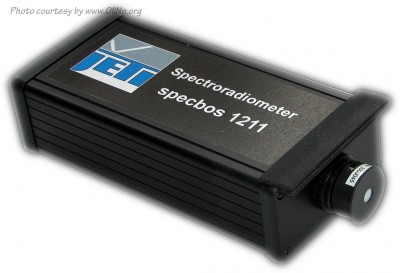
The SpecBos 1211 spectro radio meter of the brand Jeti
These measurement devices are expensive (> 5000 Euro). Calibration is done with a light bulb emitting light with a known spectrum; of each little area of wavelength it is well known how much energy is in there, and this is then used to correct the readings of each and every cell in the meter. For this meter it means 81 correction values. As a result every cell measures correctly the energy content (in W/m2/nm) of light of a narrow band of wavelengths (5 nm width).
As the eye’s sensitivity is known and well documented, the readings of every cell can now be multiplied by the relative sensitivity of the human eye for that wavelength area to convert the power readings into lux (adapted to the human eye). This means that the human eye’s sensitivity is perfectly implemented in this operation.
The specs of the meters
The meters taken as an example are used to measure the illumiance of a number of light bulbs that emit light of a different spectrum. Then we are able to compare the retrieved measurement results. But before that, what can we expect? Let’s have a look at the respective specifications and see what they mean.
The CEM DT-1309 luxmeter.
The spec reports the following:
1) Spectral response: CIE Photopic (CIE human eye response curve)
–>So the meter uses the human daylight sensitivity curve, which is correct and OK
2) Spectral Accuracy: CIE Vλ function f1′≤6%
–>The approximation of the daylight sensitivity curve of the human eye is as close as 6 %. However this device only measures with one light sensitive cell, with its own light sensitivity curve that does not match the human’s one. So it makes use of a filter to match the human eye sensitivity curve. So it is now to be seen whether this approximation is good enough to generate accurate results, also for light with spectra coming from different kinds of more actual light bulbs (LED in particular).
3) Accuracy: ± 5% rdg.±10d. (<10,000Lux), ± 10% rdg.±10d. (>10,000Lux)
–> The accuracy means how far the measurement device can deviate from the real value (better is to say, how much uncertainty does this device add? As the real real value is never known, no matter what measurement device). 5 % is not at all a bad value for light quantities as lux. However pay attention to calibrate the device according to the manufacturer’s recommendations. This type with one cell not matched with its spectral sensitivity, does not have a calibration schedule, but the more expensive ones with matched sensitivity curves can be offered for calibration, most likely once per year but also once per two years is common.
4) Repeatability: ± 3%
–> When repeatedly measurements are taken, then one can expect the results to be within 3 % of each other.
5) Photo Detector: One silicon photo diode and spectral response filter
–> Here explicitly stated: one light sensitive cell us used, with its own light sensitivity. With “spectral response filter” is meant a filter to match the sensitivity curve for both cell and filter to that of the human eye.
The SpecBos 1211 radio spectro meter
This meter has been calibrated and herewith a part of the calibration report.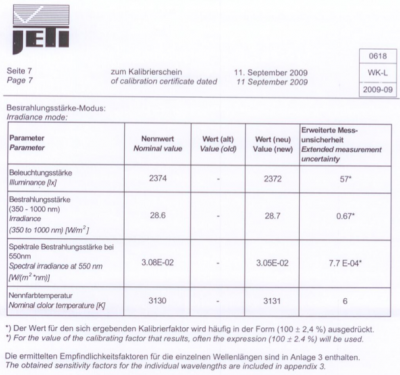
The results of the calibration of the illuminance (lux)
The meter is calibrated on one value. Calibration values are determined for each and every light sensitive cell (in appendix 3 all single correction values are reported is what the sheet tells). The inaccuracy is in the order of ±2.4 % (per cel).
Specific consultation at Jeti learns that these measurement devices are checked (after calibration) on light with about 20 different light spectra, and the reported lux value is verified.
Measurements done on light with different spectra
Light bulbs with different spectra are measured with the two discussed lex meters. Then results compared. With the radio spectro meter also the spectrum is reported, so that easily can be seen what the effect is of the spectra on the difference of the measurement results.
Both lux meters were measuring the same lamp at the same distance.
100W incandescent light bulb
| Spectrum | 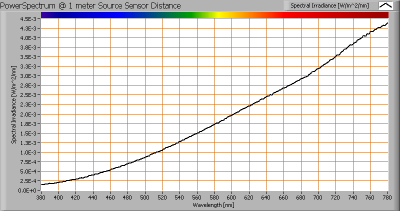 |
| CEM DT-1309 | 315 lx |
| SpecBos 1211 | 298 lx |
| Difference | 5.4 % |
The difference is computed as (Ev_CEM – Ev_SpecBos)/Ev_CEM * 100 %.
A difference of 5.4 % is perfectly possible, as it is within the max difference expected of being 5 % + 2.4 % = 7.4 %. The luxmeter measures more than the SpecBos.
Energy saving light bulb (CFL)
| Spectrum | 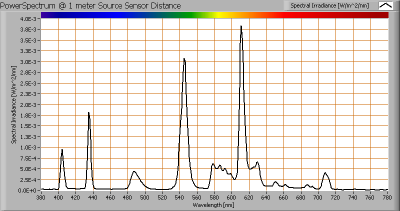 |
| CEM DT-1309 | 85 lx |
| SpecBos 1211 | 103 lx |
| Difference | -21 % |
The difference is 21 %, where the luxmeter measures less than the SpecBos. This difference of 21 % cannot be explained looking at the specs of the devices. The difference is even higher when comparing to the result on incandescent light bulb: 21 + 5 = 26 %.
RGB ledlamp
| Spectrum | 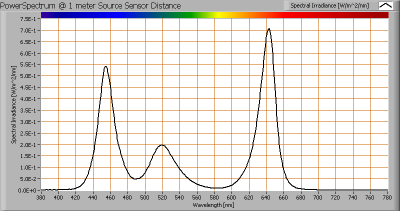 |
| CEM DT-1309 | 2900 lx |
| SpecBos 1211 | 2008 lx |
| Difference | 31 % |
The difference is 31 % where the lux meter measures more than the SpecBos (looking at these results, we say in The Netherlands: it can rain and it can shine: we cannot really forecast what the difference will be in this case).
Led light bulb with neutral white light
| Spectrum | 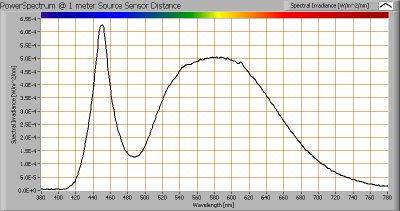 |
| CEM DT-1309 | 73 lx |
| SpecBos 1211 | 83 lx |
| Difference | -14 % |
Neutral white light is one type of white light that is very popular for working environments. Also the colos are normally more appreciated when using neutral white light.
Now if measurements are done on working spots, with the mentioned luxmeter, then the results are 14 % less than the calibrated SpexBos meter, and 19 % less than compared with the luxmeter’s own reading on light coming from an incandescent light bulb.
Led light blub with warm white light including red
| Spectrum | 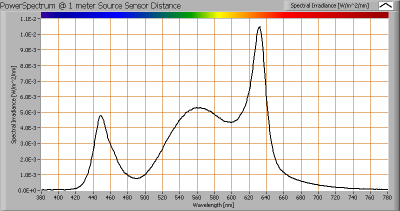 |
| CEM DT-1309 | 275 lx |
| SpecBos 1211 | 317 lx |
| Difference | -15 % |
Herewith a led light bulb with warm white leds and including a red led, to increase the CRI result. In this case the lux meter measures significantly less than the spectro radio meter.
Led light bulb with warm white light
| Spectrum | 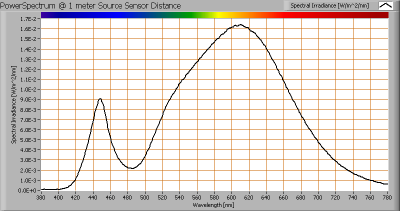 |
| CEM DT-1309 | 850 lx |
| SpecBos 1211 | 833 lx |
| Difference | 2 % |
It appears that the difference is very small. But who can gues that that will be the case, looking at the previous results?
Discussion of the results
The luxmeter and the spectro radio meter give different lux values depending on the spectrum of the measured light. The spectro radio meter is the type of measurement device that can very well correctly report the lux value coming from light with any light spectrum (within the reported inaccuracy/uncertaincy as mentioned in the calibration result). The calibration of each and every cell measuring a small wavelength band of about 5 nm wide, results in a correct determination of the energy content of the light that hits the sensors, and from there it is a simple calculation to convert the readings into lux results for the human eye.
The lux meter on the contrary has one light sensitive cell. This on itself is not bad: it reports the light measurement results very quickly. But when the used lenses, materials and the light sensitive cell have a sensitivity curve that it not matched with the human eye’s, then only a correction factor can be applied that will work with one (common) light spectrum; that of an incandescent light bulb.
Measurement comparison results show that with this technique huge errors occur when measuring light with different spectra.
Note: it is not said that every lux meter with their own light sensitive cell will report the same differences as measured in this article. This has not been researched. Where most of the time silicon is used as light sensitive diode, these have essentially the same sensitivity for light. However some specific treatments of the cell, e.g. using filters on top of them for protecting them against for instance moisture, can result in a different sensitivity and therefore different comparison results.
Note II: there are lux measurement devices that have selected or tuned optics that together with the light sensitive cell result in a very good (class L, better than 1.5 %) approximation of the human eye’s daytime sensitivity curve. This type of meter was not available for comparison (yet). However even with this type of meter considerable deviations between measurement device sensitivity and human eye sensitivity can be present when looking at small wavelength areas. Therefore it can be interesting to compare the spectro radio meter’s result with a lux meter of this type.


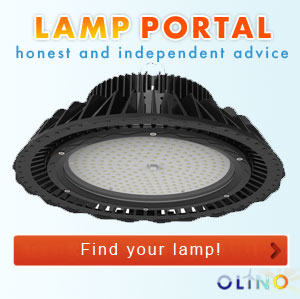


1 reply on “Measuring Illuminance Correctly”
Lumens per square meter equal one lux. A working example is a light source that produces a total of 1000 lumens of light (luminous flux). We would have 1000 lux of illumination if we could concentrate this onto a surface that was 1 square meter in size.